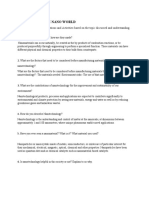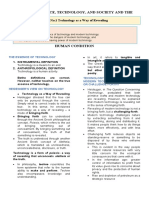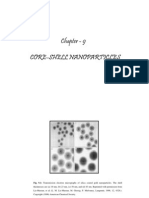Activity Sheet On Nanotechnology: PART 1 Key Terms and Ideas
Activity Sheet On Nanotechnology: PART 1 Key Terms and Ideas
Uploaded by
Ro-Anne Felipe SanchezCopyright:
Available Formats
Activity Sheet On Nanotechnology: PART 1 Key Terms and Ideas
Activity Sheet On Nanotechnology: PART 1 Key Terms and Ideas
Uploaded by
Ro-Anne Felipe SanchezOriginal Title
Copyright
Available Formats
Share this document
Did you find this document useful?
Is this content inappropriate?
Copyright:
Available Formats
Activity Sheet On Nanotechnology: PART 1 Key Terms and Ideas
Activity Sheet On Nanotechnology: PART 1 Key Terms and Ideas
Uploaded by
Ro-Anne Felipe SanchezCopyright:
Available Formats
Activity Sheet on Nanotechnology
PART 1 Key Terms and Ideas
Direction: Define or describe the following important terms associated to nanotechnology.
Terms Definition/Description
the study of structures and materials on an ultra-small scale. The
1. Nanoscience physical and chemical properties of matter change at the nano level.
The nanoscopic scale (or nanoscale) usually refers to structures with
2. Nanoscale a length scale applicable to nanotechnology, usually cited as 1–100
nanometers. A nanometer is a billionth of a meter.
a field of research and innovation concerned with building 'things' -
3. Nanotechnology generally, materials and devices - on the scale of atoms and
molecules
defined as materials possessing, at minimum, one external
4. Nanomaterials dimension measuring 1-100nm.
he production of nanoscaled materials, which can be powders or
5. Nanomanufacturing fluids, and the manufacturing of parts "bottom up" from nanoscaled
materials or "top down" in smallest steps for high precision, used in
several technologies such as laser ablation, etching and others.
a branch of medicine that applies the knowledge and tools of
6. Nanomedicine nanotechnology to the prevention and treatment of disease. It
involves the use of nanoscale materials
a subfield of metrology, concerned with the science of measurement
7. Nanometrology at the nanoscale level. Nanometrology has a crucial role in order to
produce nanomaterials and devices with a high degree of accuracy
and reliability in nanomanufacturing
the branch of nanotechnology concerned with the study and
8. Nanolithography application of the nanofabrication of nanometer-scale structures,
meaning nanopatterning with at least one lateral dimension between
the size of an individual atom and approximately 100 nm.
a discipline in which tools from nanotechnology are developed and
9. Nanobiotechnology applied to study biological phenomena. For example, nanoparticles
can serve as probes, sensors or vehicles for biomolecule delivery in
cellular systems
a technology allowing to arrange nano-sized structural units, usually
10. Nanoarchitectonics a group of atoms or molecules, in an intended configuration.
PART 2 Guide Questions for Discussion
Direction: Briefly answer the following questions leading to the central idea of our discussion on
Nanoscience and Nanotechnology.
1. What are nanomaterials and how are they made?
Nanomaterials can occur naturally, be created as the by-products of combustion reactions.
strategies are used to produce nanoparticles/nanomaterials 'top-down' and 'bottom-up'. The term
'top-down' refers here to the mechanical crushing of source material using a milling process. In
the 'bottom-up' strategy, structures are built up by chemical processes.The selection of the
respective process depends on the chemical composition and the desired features specified for
the nanoparticles.
2. What are the factors that need to be considered before manufacturing materials through
nanotechnology?
Nanomaterials can be designed to improve strength, flexibility, durability, lubricity and electrical
conductivity compared to standard materials, as well as being resistant to numerous
environmental conditions, such as glare, moisture, temperature, corrosion and even microbes.
3. What are the contributions of nanotechnology for the improvement and sustainability of our
environment?
by saving raw materials, energy and water as well as by reducing greenhouse gases and
hazardous wastes.
PART 3 Impacts of Nanotechnology
Direction: Search for the recent applications and potential benefits of nanotechnology to the
various areas of our society. However, look also for the negative impacts of incorporating
nanotechnology to the said areas including some of the common issues and concerns related to
nanotechnology applications.
Impacts of Nanotechnology
Areas of Concern Advantages or Potential Benefits Issues and Concerns
of Nanotechnology
Nanomaterials exhibit special Increased toxicological pollution
physical and chemical properties on the environment due to the
that make them interesting for uncertain shape, size, and
novel, environmentally friendly chemical compositions of some of
1. Ecosystem and the products. the nanotechnology products
Environment
It protect drugs from being It is very expensive and its
degraded in the body before they developing cost is high, it’d
reach their target, Enhances the manufacturing is difficult
absorption of drugs into the
2. Health and cancerous cells, drugs from
Medicine interacting with normal cells
ultra-fine particles from diesel
Nanotechnology can be used to engines can get into the lungs, and
enhance the flavor and texture of a number of studies have found a
foods, to reduce fat content, or to link between these and
3. Food encapsulate nutrients such as cardiovascular diseases. Studies in
vitamins to ensure they do not animals have also confirmed that
degrade during a product's shelf nanoparticles are able to get
life through the gut wall.
Nanotechnology in Nanotechnology raises the
communication systems also possibility of microscopic
provides ability for manufacturers recording devices, which would
to produce computer chips and be virtually undetectable, One
sensors that are considerably possibility is the so-called "smart
4. Communication smaller, faster, more energy bullet," a computerized bullet that
efficient, and cheaper to could be controlled and aimed
manufacture than their present- very accurately
day modules
creation of businesses, jobs, and possibly lead to either a post-
trade scarcity economy, or alternatively
exacerbate the wealth gap
between developed and
developing nations.
5. Economy
PART 4 References
Kindly provide refences for your answers taken from the internet.
[ CITATION aus20 \l 1033 ] https://www.science.org.au/curious/nanoscience
https://www.twi-global.com/technical-knowledge/faqs/what-is-a-
nanomaterial#:~:text=Nanomaterials%20can%20be%20defined%20as,must%20measure
%20100nm%20or%20below
https://www.nanowerk.com/nanotechnology-and-the-environment.php
https://faculty.atu.edu/cgreco/ASEEmw_2011/ASEE_2011_Proceedings/Peer_Reviewed_Papers
/ASEE-MIDWEST_0030_c25dbf.pdf
https://cordis.europa.eu/article/id/30485-the-pros-and-cons-of-nanofoods
https://smallbusiness.chron.com/advantages-disadvantages-nanotechnology-37398.html
You might also like
- Science-Related Related Issues and Problems in The CountryDocument3 pagesScience-Related Related Issues and Problems in The CountryRonalyn PaunalNo ratings yet
- Chapter Viii: The Nano WorldDocument2 pagesChapter Viii: The Nano WorldCherry Ann OlasimanNo ratings yet
- Gen Ed 105 Module 3Document16 pagesGen Ed 105 Module 3Schillerie Barbero PacsaNo ratings yet
- Human Flourishing in Science and TechnologyDocument2 pagesHuman Flourishing in Science and TechnologyMary Quezia AlferezNo ratings yet
- BSED Math 1-1 (Ramirez) STSDocument1 pageBSED Math 1-1 (Ramirez) STSDos por dosNo ratings yet
- Exercise 2. Document AnalysisDocument2 pagesExercise 2. Document Analysisrjay manaloNo ratings yet
- HumanitiesDocument2 pagesHumanitiesGrace RoselioNo ratings yet
- 10-The Nano World and Gene TherapyDocument9 pages10-The Nano World and Gene Therapyrose belle garciaNo ratings yet
- 2 GE 5 Chapter 7 When Technology & Humanity CrossDocument12 pages2 GE 5 Chapter 7 When Technology & Humanity CrossKoii KintaroNo ratings yet
- Science Discoveries TimelineDocument3 pagesScience Discoveries Timelinejunior apacheNo ratings yet
- STS Module Week 7 8 ST and The Human FlourishingDocument8 pagesSTS Module Week 7 8 ST and The Human FlourishingVinz Khyl G. CastillonNo ratings yet
- STS Activity 5Document1 pageSTS Activity 5April TatadNo ratings yet
- What Is The Role of Indigenous Science in The Development of Science and Technology in The Philippines?Document5 pagesWhat Is The Role of Indigenous Science in The Development of Science and Technology in The Philippines?Chicken NoodlesNo ratings yet
- Cavite State University: GNED 06: Science, Technology, and SocietyDocument6 pagesCavite State University: GNED 06: Science, Technology, and SocietyJASY NUPT GILLONo ratings yet
- ULO 1A-"Let's Check" Activity 1. Now, That You Know The Essential Historical Antecedents of Science andDocument9 pagesULO 1A-"Let's Check" Activity 1. Now, That You Know The Essential Historical Antecedents of Science andRodante P Hernandez Jr.No ratings yet
- Info AgeDocument31 pagesInfo AgeLykaNo ratings yet
- Agreement or Disagreement Sugar ConsumptionDocument21 pagesAgreement or Disagreement Sugar ConsumptionBermel BerkonNo ratings yet
- Mst112 Final Reviewer Part 1Document5 pagesMst112 Final Reviewer Part 1John MichaelNo ratings yet
- Unit II Activities: Aileen B. Bagsic BSA 1-2Document17 pagesUnit II Activities: Aileen B. Bagsic BSA 1-2Aileen BagsicNo ratings yet
- Art App (Midterm) LoraDocument28 pagesArt App (Midterm) LoraLORA, Kaye G.0% (1)
- Activit Yin Sts If InventorDocument2 pagesActivit Yin Sts If InventorANGELA ARNELLE BOONo ratings yet
- Assessment: IDENTIFICATION: Read The Questions Carefully. Write Your Answer Before The NumberDocument3 pagesAssessment: IDENTIFICATION: Read The Questions Carefully. Write Your Answer Before The Numberlevine millanesNo ratings yet
- Gee-1 SG2Document9 pagesGee-1 SG2hokai hokaiNo ratings yet
- Technology and Ge-Sts: ScienceDocument19 pagesTechnology and Ge-Sts: ScienceJayran BolonganNo ratings yet
- Benjamin CabreraDocument11 pagesBenjamin CabreraElle CruzNo ratings yet
- Lesson 3 Science and Technology in Nation BuildingDocument4 pagesLesson 3 Science and Technology in Nation BuildingRanniel EstrellaNo ratings yet
- Ge 7 Module 1Document16 pagesGe 7 Module 1Mary Grace Balus LegaspoNo ratings yet
- Science Technology and Society and The Human ConditionDocument12 pagesScience Technology and Society and The Human ConditionCRISTY C. MANALONo ratings yet
- Contemp Final NaDocument7 pagesContemp Final NaJhon Marvin Arienza100% (1)
- Science, Technology, & Society: Human FlourishingDocument11 pagesScience, Technology, & Society: Human FlourishingSN DNo ratings yet
- Chapter 5 ReflectionDocument4 pagesChapter 5 ReflectionMc PeNo ratings yet
- Ladroma, Ciara C. Bsm-Iv STS 10 - Science, Technology and Society Lesson 1: Historical Antecedents of Science and TechnologyDocument4 pagesLadroma, Ciara C. Bsm-Iv STS 10 - Science, Technology and Society Lesson 1: Historical Antecedents of Science and TechnologyCiara Ladroma100% (1)
- Activity 1 in STSDocument5 pagesActivity 1 in STSOmar Aculan100% (1)
- STS - Future ActionsDocument13 pagesSTS - Future ActionsBarbie BleuNo ratings yet
- Why Environmental Education Is ImportantDocument9 pagesWhy Environmental Education Is ImportantAurangzeb ChaudharyNo ratings yet
- When Technology AND Humanity CrossDocument42 pagesWhen Technology AND Humanity CrossChristian Valerio TabilinNo ratings yet
- Forget 'Developing' Poor Countries, It'S Time To 'De-Develop' Rich CountriesDocument7 pagesForget 'Developing' Poor Countries, It'S Time To 'De-Develop' Rich Countriesirish bautistaNo ratings yet
- Le 2.1 Bertulfo - Bsa1dDocument1 pageLe 2.1 Bertulfo - Bsa1dGelo BertulfoNo ratings yet
- Jose RodriguezDocument3 pagesJose RodriguezJudel S. MaticNo ratings yet
- Technology As A Way of RevealingDocument4 pagesTechnology As A Way of RevealingGeemaica MacaraigNo ratings yet
- Module 5: Technology As A Way of Revealing: at A Glance: Who Is Martin Heidegger?Document5 pagesModule 5: Technology As A Way of Revealing: at A Glance: Who Is Martin Heidegger?Rena Jocelle NalzaroNo ratings yet
- Living in The IT Era - Module 5 - ActivityDocument4 pagesLiving in The IT Era - Module 5 - ActivityEunisse Gwen BaytamoNo ratings yet
- The Technological Advancement of Grade-11 Students of Philippine Women'S College of Davao DURING S.Y 2017-2018Document4 pagesThe Technological Advancement of Grade-11 Students of Philippine Women'S College of Davao DURING S.Y 2017-2018kassNo ratings yet
- Technology As A Way of RevealingDocument41 pagesTechnology As A Way of RevealingJaneth Miguel SatrainNo ratings yet
- Module 1 Section 2 Lecture Slides STUDENTDocument29 pagesModule 1 Section 2 Lecture Slides STUDENTJewela NogasNo ratings yet
- Is Morally Permissible in Order To Prevent A Greater EvilDocument3 pagesIs Morally Permissible in Order To Prevent A Greater EvilSuperGirl_miKNo ratings yet
- Chapters 1 and 2 STSDocument38 pagesChapters 1 and 2 STSJohn Carlo CastilloNo ratings yet
- CWTS 2.module 3Document17 pagesCWTS 2.module 3Ke NtNo ratings yet
- Jerald Jay C. Catacutan Science, Technology and Society BSA-2B T/F 2:30-4:00Document3 pagesJerald Jay C. Catacutan Science, Technology and Society BSA-2B T/F 2:30-4:00Jerald Jay Capistrano CatacutanNo ratings yet
- Article 1, The Role of Science and TechnologyDocument3 pagesArticle 1, The Role of Science and TechnologyNSBMRNo ratings yet
- Gabriel Bartholomew L. TafallaDocument4 pagesGabriel Bartholomew L. TafallaGabriel TafallaNo ratings yet
- STS 10 PDFDocument4 pagesSTS 10 PDFJuan Glicerio C. ManlapazNo ratings yet
- Science, Technology, and Nation-BuildingDocument24 pagesScience, Technology, and Nation-BuildingDominicRivaNo ratings yet
- Chapter 11: The Nano World: Science, Technology, and Society BS Psychology 1-2Document18 pagesChapter 11: The Nano World: Science, Technology, and Society BS Psychology 1-2Lance RevillaNo ratings yet
- MODULE IN ART APPRECIATION FOR CIVIL EMGINEERING Maam VickyDocument11 pagesMODULE IN ART APPRECIATION FOR CIVIL EMGINEERING Maam VickyChicken NoodlesNo ratings yet
- A Synthesis Paper On Mathematics and Nature by NumbersDocument7 pagesA Synthesis Paper On Mathematics and Nature by NumbersSebastian NarcisoNo ratings yet
- Prelims To Finals SctsDocument122 pagesPrelims To Finals SctsJoy Lucas CababagNo ratings yet
- Module 1 Historical Antecedents in The Course of Science and TechnologyDocument22 pagesModule 1 Historical Antecedents in The Course of Science and TechnologyAllyson Lois BacucangNo ratings yet
- Nanotechnology & Society Group 7 PresentationDocument20 pagesNanotechnology & Society Group 7 PresentationAie BulanadiNo ratings yet
- Sts Final Summary Reporting - MalinaoDocument3 pagesSts Final Summary Reporting - MalinaoLyca Castillo MalinaoNo ratings yet
- Energy Resources Activity 2Document9 pagesEnergy Resources Activity 2Ro-Anne Felipe SanchezNo ratings yet
- Activity Sheet On BiotechDocument3 pagesActivity Sheet On BiotechRo-Anne Felipe SanchezNo ratings yet
- Personal Protective Equipment (PPE) Is ProtectiveDocument2 pagesPersonal Protective Equipment (PPE) Is ProtectiveRo-Anne Felipe SanchezNo ratings yet
- Chapter 2 Handout 2Document7 pagesChapter 2 Handout 2Ro-Anne Felipe SanchezNo ratings yet
- Deeplearning - Ai Deeplearning - AiDocument78 pagesDeeplearning - Ai Deeplearning - AiNoura AlgadiNo ratings yet
- AI You Tube PagesDocument156 pagesAI You Tube PagesTapu HassanNo ratings yet
- Syllabus - Nano Technology Fundamentals and Applications - CO PO Mapping (53438)Document3 pagesSyllabus - Nano Technology Fundamentals and Applications - CO PO Mapping (53438)Sai DivakarNo ratings yet
- SBA EDPM by DanielDocument8 pagesSBA EDPM by DanielDanny DanNo ratings yet
- Computer Vision Is A Field of Artificial IntelligenceDocument2 pagesComputer Vision Is A Field of Artificial IntelligencefigureabcNo ratings yet
- Welcome To AI For EveryoneDocument3 pagesWelcome To AI For EveryonebharatNo ratings yet
- AFM PresentationDocument16 pagesAFM PresentationSulficker AliNo ratings yet
- Soft ComputingDocument17 pagesSoft Computingnupurbopche633No ratings yet
- AI Lec1Document16 pagesAI Lec1CG Art VfxNo ratings yet
- Deep Network With Support Vector Machines: Abstract. Deep Learning Methods Aims at Learning Features Automatically atDocument2 pagesDeep Network With Support Vector Machines: Abstract. Deep Learning Methods Aims at Learning Features Automatically atAsil AsilaNo ratings yet
- List of Affected Addresses: South End Boil Water AdvisoryDocument83 pagesList of Affected Addresses: South End Boil Water AdvisoryAlexa HuffmanNo ratings yet
- EDU Detailed Drawings Exercises 2017Document51 pagesEDU Detailed Drawings Exercises 2017gulshanNo ratings yet
- ML Lecture#1Document52 pagesML Lecture#1muhammadhzrizwan2002No ratings yet
- Neural-Network QuestionsDocument3 pagesNeural-Network Questions66umer660% (1)
- Car Damage Detective: Assessing Car Damage With Convolutional Neural Networks Ting NeoDocument11 pagesCar Damage Detective: Assessing Car Damage With Convolutional Neural Networks Ting NeoPravin KannaNo ratings yet
- AI & Machine Learning With PythonDocument3 pagesAI & Machine Learning With PythonNandu Director ProjectsNo ratings yet
- Chapter - 9 Core-Shell NanoparticlesDocument19 pagesChapter - 9 Core-Shell NanoparticlesPrasanta KalitaNo ratings yet
- Machine Learning - Classification: CS102 Winter 2019Document36 pagesMachine Learning - Classification: CS102 Winter 2019technetvnNo ratings yet
- Car Number Plate Recognition SystemDocument10 pagesCar Number Plate Recognition Systemsoyofi3977No ratings yet
- ISTE Faculty Chapter - MH286 Sardar Patel Institute of Technology PresentsDocument4 pagesISTE Faculty Chapter - MH286 Sardar Patel Institute of Technology PresentspdhurveyNo ratings yet
- Creating Futures in Robotics & AI: With Carnegie Mellon UniversityDocument2 pagesCreating Futures in Robotics & AI: With Carnegie Mellon UniversityJeffrey ZhangNo ratings yet
- (SOTA) Deep Learning in Multi-Object Detection and Tracking State of The ArtDocument30 pages(SOTA) Deep Learning in Multi-Object Detection and Tracking State of The ArtSteve Ristian LukardieNo ratings yet
- Robotics and Automation - Unit-1 (Part 2)Document70 pagesRobotics and Automation - Unit-1 (Part 2)jaiganeshNo ratings yet
- Konvergen AI - Build An AI CompanyDocument16 pagesKonvergen AI - Build An AI CompanyhendroshadiNo ratings yet
- Facial K: Dynamic Selfie Filters Using MLDocument10 pagesFacial K: Dynamic Selfie Filters Using MLdeepika joshiNo ratings yet
- Topic: A. Timeline in The History of RoboticsDocument6 pagesTopic: A. Timeline in The History of RoboticsSalvador G. Yadao100% (1)
- Activity Guide - Lesson 1 Introduction To Machne Learning - Classifying FishDocument2 pagesActivity Guide - Lesson 1 Introduction To Machne Learning - Classifying FishEver MontoyaNo ratings yet
- Modern Digital MarketingDocument9 pagesModern Digital MarketinggucciloungestoreNo ratings yet
- (IJCST-V11I6P2) :ms. Madhuri P. Narkhede, Dr. Harshali B PatilDocument5 pages(IJCST-V11I6P2) :ms. Madhuri P. Narkhede, Dr. Harshali B PatilEighthSenseGroupNo ratings yet
- Lab PRGMDocument16 pagesLab PRGMNitesh HuNo ratings yet





























































































